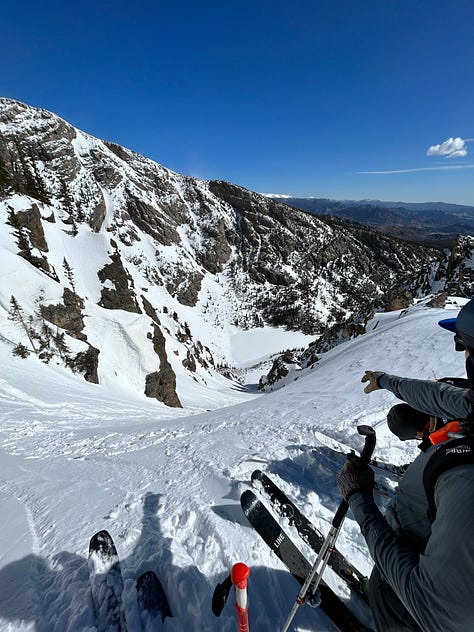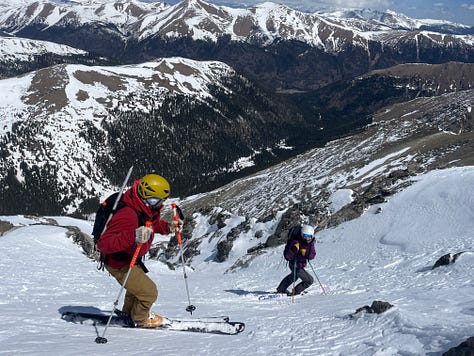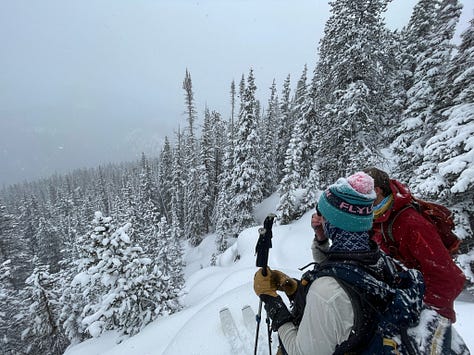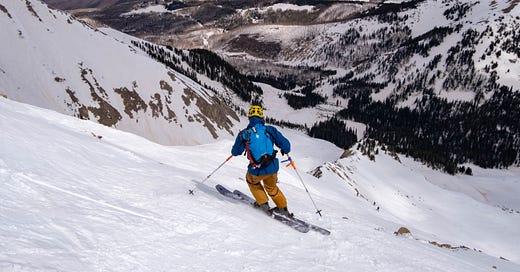In an interview, writer Jon Krakauer, author of Into the Wild and Into Thin Air, is asked about what the interviewer calls “the thin line between adventure and craziness.” Krakauer disagrees with the use of the word “craziness”, instead preferring to center the conversation on risk:
It’s something about the irresponsibility of risk. We who do it justify it by [saying] we’re careful and it’s not reckless. It’s very calculated. We do things that we’re pretty certain we’ll survive. But that’s kind of bullshit. You can’t control what you do in nature—you can’t control things like avalanches and rockfall and I’ve come to admit the risks I’ve taken aren’t really morally justifiable in some cases. I certainly don’t take risks like that right now—the climbing I do now is dialed way down and just as satisfying.
Trying to exert at the limit of your physical and mental capacities is very rewarding. It doesn’t always have to involve risk, but risk makes it so much more interesting and meaningful. It compels you to focus so much more intensely. If you lose a tennis match, your ego is wounded but there’s no real penalty. If you screw up on a climb, you’re going to die.
Krakauer, like me, lives in Boulder, Colorado. The sad but steady stream of rescues, injuries, and, yes, deaths around the Front Range make conversations surrounding risk in mountain sports perennial topics among my friends and community.
Risk can be relative. Building skills and acquiring familiarity through exposure to risk will often increase someone’s comfort or the level of risk they deem acceptable. The first time I ever skied a blue ski run, considering I could hardly turn (or stop, for that matter), it felt like risking death; after a few seasons, the same run would be a warm-up, skied backwards. Increasing my skills reduced the risk of tackling a given objective.
Risk is also objective. Bad weather or rockfall are objective hazards: they simply exist as risks in the alpine. While a helmet might reduce the consequence of a falling rock hitting you in the head, it's can’t change the likelihood a rock is going to fall. What can change that likelihood is having the knowledge, intuition, and expertise to spot and skip pulling on loose blocks, or to belay from a protected stance, or to avoid rockfall zone late in the day when higher temps/melting snow send rocks tumbling.
While these observations about risk apply to most activities in the alpine, from rock climbing to trail running, the following table examines backcountry skiing:

This table is excerpted from Staying Alive in Avalanche Terrain by Bruce Tremper, the bible of avalanche safety. It illustrates how in the world of backcountry snow travel, being right 99% of the time is not good enough.1 You need to be perfect, or as close to perfect as you can be.
Actuarial tables bring me, finally, to venture capital—and that’s not because talking about VC makes me want to die, actually. The risk mandate of a VC couldn’t be more different from a skier. If a VC invests in 99 companies that fail, and one Facebook/Amazon/Tesla, then they’ve won. VCs need unicorns for their business model to work. Middling success is not sufficient to hit their hurdles: they need to find home runs or their fund is a failure.2
Venture capitalists and backcountry skiers both define success by tail events: venture capitalists’ returns are mostly determined by huge successes (the far upside), while backcountry travelers want to avoid getting injured or worse (the far downside).
While their success may be defined in opposite terms, both venture capitalists and backcountry skiers know risk like old friends. Both groups have to carefully calculate risk in their everyday life, whether at the office or on the snow. To some extent, risk creates the activity. Without risk, there wouldn’t be outsize returns available to VCs; without risk, as Jon Krakauer noted in the intro, skiing would lack interest and, more importantly to me, meaning.
In Nate Silver’s newest book, On the Edge: The Art of Risking Everything, he slices the world into two camps: the River and the Village. In the River, Silver includes hedge fund managers, cryptocurrency traders, economists, utilitarian philosophers, gamblers, and, yes, venture capitalists. From the Guardian’s review of the book:
People of the River – “Riverians”, if you will – have a rational understanding of risk (poker and blackjack players know all the probabilities) and know when to bet big and when to fold. They are likely to be geeks and libertarians. All this makes them unlike the inhabitants of a rival parallel world, “the Village”, where politicians, regulators, academics and media types live, driven by emotions and hunches.
Strange bedfellows they may be, but backcountry skiers, at least ones that have been doing it for a while, have to be in the River with the rest of them. They can’t afford to be driven by emotions and hunches, at least not for long.
I’ll leave you with this quote from Joe Stock’s article on avalanche safety called Luck and Avoiding Avalanches. The author quotes skier Aaron Money:
Skill and experience are how you change probabilities. Luck determines what side of the probability you fall on.
This statement applies to venture capital, staying alive in the backcountry, and all other facets3 of life, really. I plan to continue falling on the right side of the distribution, doing what I can to change the odds in my favor.



Thanks to Ian for sharing the Avalanche Review article with me and always being game to share a PSP and talk about risk.
If any reader happens to be both a backcountry skier and venture capitalist, please let me know.
I could quibble with the numbers they used there—unless you’re a professional ski guide (or a professional ski bum), you aren’t spending 100 days/year in avalanche terrain. But the numbers Tremper used make the math easy and it’s worth being generous in the risk assessment here, given what’s at risk.
Taken from Nate Silver’s On The Edge is a rough breakdown of how well Andreessen Horowitz (top VC firm) does on its investments: 25% of investments make no return; 25% produce a return between 0x and 1x; 25% produce a return of 1x-3x; 15% return 3x-10x; the top 10% return 10x or greater.





This was so thought-provoking... wow. The last bit about river vs. village is so fascinating because as much as I'd like to say the people of the River and Village are two versions of the same folk. But it's in the act of someething or rather in our devotion/delusion to it that we choose to be in the River or in the Village. And that choice - in favor of the Stock quote - is defined by skill and experience, because it doesn't matter whether you're in the River or Village, an avalanche may wipe both. But the odds can be on your favor on a good day.
My favorite posts are writers making connections I’ve never considered between topics I’m interested in. This was great.
I have been outlining a post on my experiencing working for lawyers (Open Society Foundations and Hewlett Foundation), who focus on minimizing risk/harm through regulation, versus entrepreneurs (Omidyar Network and Gates Foundation) who make big bets on risky ideas that rarely succeed. Minimizing harm and betting on risky projects both seem like worthy goals and it’s good to see so much action on both ends of the AI spectrum.
Does Nate Silver touch on how much of the difference between the river and village is nature versus nurture? Are lawyers destined to go to law school based on their personality traits? If you forced all the MBA kids to go to law school and vice-versa, would they trade places?